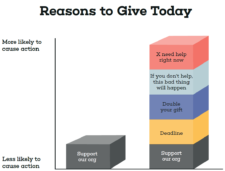I’m fresh off the plane from last week’s Storytelling Conference, and there’s something I forgot to share.
It’s a simple, story-based tool for anyone who wants to try a fundraising approach that’s new to their organization… and needs to get their boss to approve it.
This tool doesn’t make it easy – a fundraising approach that’s new can challenge beliefs people have about how fundraising works. And beliefs don’t easily change. But it’s a start, so here goes…
Step 1 – Share What You Learned
Share the new strategy, tactic or approach that you learned at the conference.
Step 2 – Tell Your Story
Share how the knowledge of new strategy or tactic changed how you think. Give examples if you can, saying things like, “I used to think that it worked like X, but now I see that it can work like Y.”
Share how you think that the approach could help your organization raise more money and achieve more of your mission.
Step 3 – Share Why You Can’t Believe
Confess that you now wonder if the previous approach you took is really the best approach. You’re not “proclaiming” here – that can put people on the defensive because the meta is that “you’re right and they’re wrong” – and we don’t want that.
Confess that you’re wondering if the current way of doing things is raising less money than you could be and holding your organization back from doing more.
Step 4 – Share Your Conflict
Acknowledge that by sharing this you’re aware that it upsets the status quo, and that you don’t enjoy doing that.
Step 5 – “What Should I Do About This?”
Ask a simple, direct question: “What should I do about this?”
Be a good listener.
You may get shut down. You may find that there’s a possibility of trying the new approach.
Regardless, be solutions-oriented. Offer to look for a low stakes place to try the idea. Perhaps you can try it in an e-appeal during a dead time of the year? If people are worried about the Board’s reaction, take the Board off the send list.
Step 6 – Remember That You Are On The Same Team
If your organization is completely against the new approach, now you know.
But you will have honored the organization by introducing a new idea in a sensitive, thoughtful way. Their reaction is up to them.
What comes next is up to you. Some people in this situation will bring the idea up again a few months later. Some people will leave the organization. Whatever your approach is, remember that you’re on the same team right now.
Step 7 – You Can Always Ask For A Do-Over
If there’s no tolerance for failure, there’s no innovation.
That goes for your organization; if your organization isn’t willing to fail, they won’t be willing to try your idea.
But in this moment it also goes for you – you tried a new approach to get a new idea approved. And kudos to you; you took the vulnerable approach, tried to innovate, and were willing to fail. Good on you.
If it didn’t work, you can thank the person for listening, and in most cases you can ask if you can try again later.
In My Experience…
If you present a challenging idea in a sensitive, thoughtful way, you have a better chance of getting in a conversation about it.
If you get in a conversation about it, you have a better chance of it getting approved.
So whether you’re back from the conference and have a head full of new ideas that conflict with “the stories your organization tells itself about fundraising,” or just read about an idea that you want to try, give this approach a go.
Steven Screen is Co-Founder of The Better Fundraising Company and lead author of its blog. With over 30 years' fundraising experience, he gets energized by helping organizations understand how they can raise more money. He’s a second-generation fundraiser, a past winner of the Direct Mail Package of the Year, and data-driven.









Even if there’s no or little external resistance, I still face some internal resistance. What if I fail? What if I spend more money and don’t raise more money? Then I remind myself that I won’t know the outcome if I don’t try. I must have this internal conversation several days a week, if not daily. At the Storytelling conference, Steven said to try 3 awkward things after we got back to the office. I keep reminding myself of that goal and push forward.
It’s so good to remember that every organization started small, tried stuff that didn’t work, tried things that felt awkward but worked, etc. Doing the same things will mostly likely result in raising the same amount. Which means that the awkward, new things to try are good and necessary steps to organizational growth!
After the very first meeting at the conference, How to raise 21% more money next year, I texted my boss, ” I’ve been to one session so far and can already tell we’ll want to have a lengthy chat about a fundraising plan next week”. The whole conference was eye-opening! I’m really energized to implement some of the things I learned. My boss and I chatted about how we really needed to change many of the ways we were looking at fundraising and he was very open to the shift. I’m looking into software to help in the effort as well- which will be another conversation. Thanks for all of the incredibly helpful information!
You’re welcome, Christy!